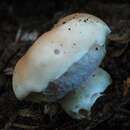en
names in breadcrumbs


Boletus semigastroideus is a species of secotioid fungus in the family Boletaceae. It was originally described in 1942 as Secotium areolatum by New Zealand-based mycologist Gordon Herriot Cunningham and then renamed as Notholepiota areolata as the type species of the genus Notholepiota by Egon Horak in 1971.[2] A molecular phylogenetics study found it to belong in Boletus sensu stricto, but the name Boletus areolatus was preoccupied, so it was renamed Boletus semigastroideus.[3]
Boletus semigastroideus is a species of secotioid fungus in the family Boletaceae. It was originally described in 1942 as Secotium areolatum by New Zealand-based mycologist Gordon Herriot Cunningham and then renamed as Notholepiota areolata as the type species of the genus Notholepiota by Egon Horak in 1971. A molecular phylogenetics study found it to belong in Boletus sensu stricto, but the name Boletus areolatus was preoccupied, so it was renamed Boletus semigastroideus.